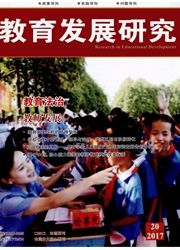

 中文摘要:
中文摘要:
本文基于CCSS(中国大学生学习与发展追踪研究)的南京某工科高校2008级本科生四年的追踪数据,在绘制图形进行初步探索,以及利用MPLUS工具构建三类潜变量增长模型(潜变量线性增长模型、非线性二次增长曲线模型和不定义曲线类型的增长曲线模型)基础上,探究了大学期间学生学习成果增长的轨迹和规律。研究发现:(1)大学期间学生学习成果以及知识、能力和价值观三维度成果增长均呈曲线发展轨迹,且增速低于线性发展速度;(2)学习成果四年间知识增长总量大于能力以及价值观增长总量,且一至二年级增值最大,之后增幅尺度逐年减小;(3)学习成果初始水平(一年级测量)和增长速度均存在显著的个体差异,初始水平越高者增速越慢;(4)存在除时间外的影响学习成果增值的因素。针对以上学习成果增长规律,提出如下教育建议:(1)认识学习成果增长的曲线轨迹,依据规律开展教育;(2)抓住学生成长的关键期,实现学习成果增值的最大化;(3)关注学习成果增值的个体差异,提高教育的针对性;(4)探究影响学习成果增值的因素,重视大学之于学生发展的作用。
 英文摘要:
英文摘要:
Based on the longitudinal research data of CCSS(Chinese College Student Survey) on the undergraduates enrolled in 2008 at one Nanjing Engineering College and the preliminary exploration of drawing data trajectories, the study adopts MPLUStools to createthree latent growth models(latent variable linear growth model, non-linear quadratic curve growth model, and latent development model without any definition of curve types) in order to explore the trajectories and regularities of the growth of students' learning outcomes in the colleges. The results reveal that:(1) both the overall learning outcomes of students in colleges and the three-dimension outcomes of knowledge, abilities and values present curve development trajectories and regulations,and the growth rate is lower than the linear growth rate;(2) During the collegestudents' four years' study, the total amount of knowledge growth is greater than the abilities and values;(3) to pay attention to the individual differences in the value added of the study results, and improve the pertinence of education;(4) to explore the factors that affect the value added of the learning achievement, and pay attention to the role of the university in the development of the students.
 同期刊论文项目
同期刊论文项目
 同项目期刊论文
同项目期刊论文
 期刊信息
期刊信息
